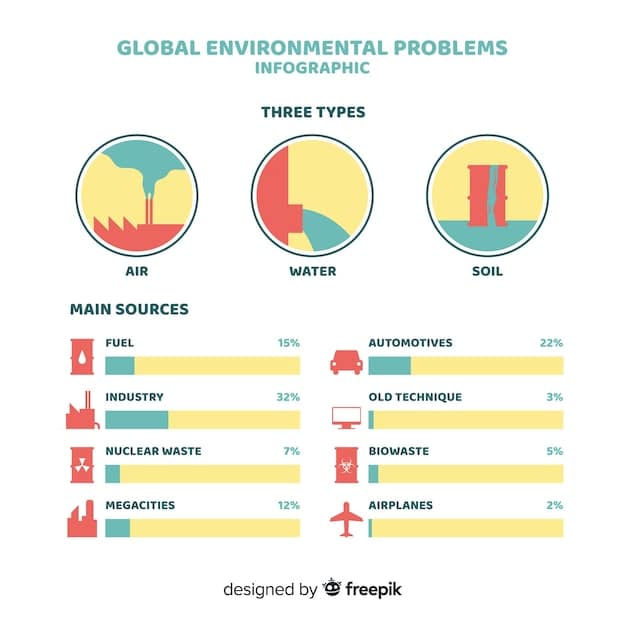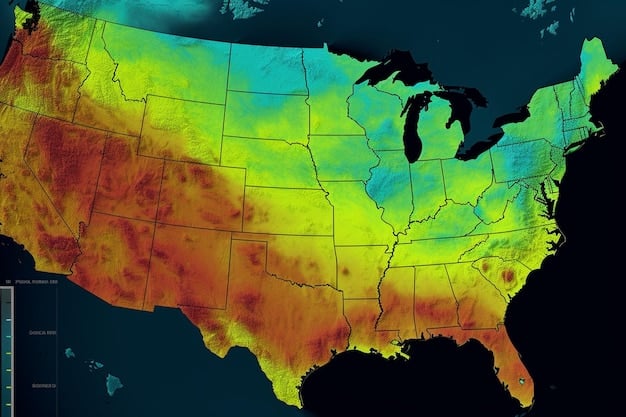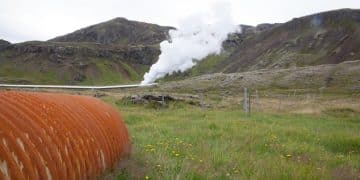Geothermal Energy: Powering US Homes in 2025

Geothermal energy leverages the Earth’s internal heat for sustainable home heating and cooling, offering a consistent renewable energy source projected to become increasingly viable in the US market by 2025 through technological advancements and supportive policies.
Imagine tapping into the Earth’s constant, natural heat to warm your home in the winter and cool it in the summer. Geothermal Energy: Unlocking the Earth’s Power for Home Heating and Cooling in 2025 is becoming an increasingly attractive option for homeowners in the US seeking sustainable and cost-effective energy solutions. How can you take advantage of this renewable resource?
Geothermal Energy Basics: A Primer
Geothermal energy, at its core, is simply the heat from within the Earth. This heat, a remnant from the planet’s formation and ongoing radioactive decay, is a vast and constantly replenishing resource. Harnessing it for heating and cooling offers a stable and environmentally friendly alternative to traditional fossil fuels.
Unlike solar or wind power, geothermal energy is available 24/7, regardless of weather conditions. This reliability is a major advantage, making it a dependable source for home comfort.
How Geothermal Systems Work
Geothermal heating and cooling systems, also known as ground source heat pumps (GSHPs), don’t directly pump hot water from underground. Instead, they utilize the stable temperature of the Earth a few feet below the surface.
Here’s a simplified breakdown:
- Ground Loop: A system of underground pipes, usually made of polyethylene, is buried in the ground. These pipes contain a water-based or refrigerant solution.
- Heat Pump: A heat pump circulates the solution through the ground loop, absorbing heat from the Earth in the winter and transferring heat back into the Earth in the summer.
- Distribution System: The heat pump transfers the heat to a home’s existing ductwork or radiant heating system, providing heating and cooling as needed.
This process leverages the fact that the ground temperature remains relatively constant year-round, typically between 50°F and 60°F (10°C and 16°C) in most parts of the US. This consistent temperature makes geothermal systems highly efficient.
In conclusion, geothermal energy offers a reliable and sustainable way to heat and cool homes by tapping into the Earth’s consistent underground temperature through a system of ground loops and heat pumps.
The Benefits of Geothermal Home Heating and Cooling
Switching to a geothermal system offers a multitude of advantages, from significant cost savings to a reduced environmental footprint. These benefits are driving increasing interest in geothermal solutions for homeowners across the US.
Let’s delve into the specific advantages:
Cost Savings and Return on Investment
While the initial investment in a geothermal system can be higher than traditional HVAC systems, the long-term cost savings are substantial. Geothermal systems are significantly more energy-efficient, often reducing energy bills by 30-70%.
Several factors contribute to these savings:
- Higher Efficiency: Geothermal heat pumps can transfer 3-5 units of energy for every 1 unit of electricity consumed, making them far more efficient than traditional furnaces or air conditioners.
- Reduced Maintenance: Geothermal systems typically require less maintenance than conventional HVAC systems due to fewer moving parts and their protected underground location.
- Longer Lifespan: Geothermal systems can last for 20-25 years, with the ground loop potentially lasting for 50 years or more.
Environmental Advantages
Geothermal energy is a clean and renewable resource with a minimal environmental impact. By reducing reliance on fossil fuels, geothermal systems help to:
- Reduce Greenhouse Gas Emissions: Geothermal systems produce significantly fewer greenhouse gas emissions compared to traditional heating and cooling systems.
- Conserve Natural Resources: Geothermal energy utilizes a readily available and sustainable resource, reducing the demand for finite fossil fuels.
- Improve Air Quality: By reducing reliance on combustion-based heating systems, geothermal energy helps to improve air quality, particularly in urban areas.

In summary, geothermal systems offer compelling benefits for homeowners, including long-term cost savings through higher energy efficiency and a significant reduction in environmental impact by minimizing greenhouse gas emissions and conserving natural resources.
Technological Advancements Driving Geothermal Adoption
Ongoing advancements in geothermal technology are making these systems more efficient, affordable, and accessible. These innovations are crucial for expanding the adoption of geothermal energy for home heating and cooling.
Here are some key areas of progress:
Enhanced Drilling Techniques
Advancements in drilling technology are reducing the cost and time associated with installing ground loops. Directional drilling and improved drilling equipment allow for more efficient and precise installation, even in challenging geological conditions.
These improvements translate to:
- Lower Installation Costs: Faster and more efficient drilling reduces labor costs and overall project expenses.
- Wider Applicability: Improved drilling techniques allow for geothermal installations in a wider range of soil types and geological formations.
- Minimized Disruption: More precise drilling techniques minimize disruption to landscaping and surrounding areas.
Smart Grid Integration
Integrating geothermal systems with smart grids allows for optimized energy usage and improved grid stability. Smart grid technologies can monitor and control geothermal systems, allowing them to respond to changing energy demands and grid conditions.
This integration enables:
- Peak Load Reduction: Geothermal systems can be programmed to reduce energy consumption during peak demand periods, easing strain on the grid.
- Improved Grid Reliability: Geothermal systems can provide grid operators with a dispatchable source of renewable energy, enhancing grid stability.
- Enhanced Energy Management: Smart grid integration allows homeowners to monitor and manage their energy consumption more effectively.
In conclusion, technological advancements in drilling techniques and smart grid integration are making geothermal systems more affordable, accessible, and efficient, facilitating wider adoption for home heating and cooling.
Policy and Incentives Supporting Geothermal Energy in the US
Government policies and financial incentives play a crucial role in promoting the adoption of geothermal energy in the US. These initiatives help to offset the initial cost of installation and make geothermal systems more attractive to homeowners.
Here’s an overview of key support mechanisms:
Federal Tax Credits
The federal government offers tax credits for homeowners who install qualified geothermal systems. These credits can significantly reduce the upfront cost of installation, making geothermal more financially viable.
Key aspects of the federal tax credit include:
- Investment Tax Credit (ITC): The ITC provides a percentage-based tax credit for the cost of installing a geothermal system.
- Eligibility Requirements: To qualify for the ITC, the geothermal system must meet certain performance standards and be installed in a primary residence.
- Credit Amount: The amount of the ITC can vary depending on the specific system and the prevailing tax laws.
State and Local Incentives
Many state and local governments offer additional incentives for geothermal installations, such as rebates, grants, and low-interest loans. These incentives can further reduce the cost of adopting geothermal energy.
Examples of state and local incentives include:
- Rebates: Direct cash rebates for the purchase and installation of geothermal systems.
- Grants: Funding for geothermal projects, particularly in underserved communities.
- Low-Interest Loans: Financial assistance for homeowners to finance the installation of geothermal systems.

In conclusion, federal tax credits and various state and local incentives are instrumental in fostering geothermal energy adoption in the US by mitigating initial costs and providing financial support to homeowners.
Overcoming Challenges to Geothermal Adoption
Despite the numerous benefits of geothermal energy, several challenges hinder its widespread adoption. Addressing these obstacles is crucial for unlocking the full potential of geothermal for home heating and cooling.
Key challenges include:
High Upfront Costs
The initial cost of installing a geothermal system can be significantly higher than traditional HVAC systems, deterring some homeowners from investing in the technology. This cost includes drilling, ground loop installation, and equipment purchase.
Strategies to mitigate this challenge include:
- Financial Incentives: Expanding tax credits, rebates, and other financial incentives can help to offset the upfront cost.
- Financing Options: Offering low-interest loans and other financing options can make geothermal more accessible to homeowners with limited capital.
- Technological Advancements: Continued innovation in drilling and installation techniques can reduce costs over time.
Lack of Awareness and Education
Many homeowners are simply unaware of the benefits of geothermal energy or how these systems work. This lack of awareness can lead to hesitancy in adopting the technology.
Addressing this challenge requires:
- Public Education Campaigns: Educating the public about the benefits of geothermal energy through targeted marketing and outreach efforts.
- Industry Collaboration: Building partnerships between geothermal installers, energy providers, and government agencies to promote awareness and education.
- Demonstration Projects: Showcasing successful geothermal installations can help to dispel myths and build confidence in the technology.
In summary, high upfront costs and a lack of public awareness pose significant challenges to geothermal energy adoption, but these can be overcome through enhanced financial incentives, broader educational campaigns, and continued technological advancements.
Geothermal Energy in 2025: Projections and Outlook
Looking ahead to 2025, the prospects for geothermal energy in the US market are promising. Several factors suggest that geothermal will become an increasingly viable option for home heating and cooling.
Key trends and projections include:
Market Growth
The geothermal market is expected to experience steady growth in the coming years, driven by increasing awareness of the technology’s benefits, supportive policies, and declining installation costs.
Factors contributing to market growth include:
- Rising Energy Costs: As the cost of traditional energy sources continues to rise, geothermal becomes a more economically attractive alternative.
- Increasing Environmental Concerns: Growing awareness of climate change and the need for sustainable energy solutions is driving demand for geothermal energy.
- Government Support: Continued government support through tax credits, rebates, and other incentives will further stimulate market growth.
Technological Innovation
Continued technological advancements will likely further enhance the efficiency and affordability of geothermal systems, making them more competitive with traditional HVAC systems.
Areas of technological innovation include:
- Enhanced Geothermal Systems (EGS): EGS technologies can access geothermal resources in areas that are not traditionally suitable for geothermal development.
- Advanced Heat Pumps: New heat pump designs are improving efficiency and reducing operating costs.
- Smart Controls: Smart controls and automation are optimizing energy usage and improving system performance.
| Key Point | Brief Description |
|---|---|
| 🌎 Geothermal Basics | Harnesses Earth’s internal heat for home heating/cooling. |
| 💰 Cost Savings | Reduces energy bills by 30-70% with efficient systems. |
| 🌱 Environmental Benefits | Lowers greenhouse gas emissions, conserving resources. |
| 📈 Future Growth | Projected market expansion driven by technology and policy. |
Frequently Asked Questions
▼
Geothermal systems typically last between 20 to 25 years, while the underground loop system can last for 50 years or more. This durability makes it a long-term investment.
▼
The upfront cost can vary widely, typically ranging from $20,000 to $40,000. However, incentives and long-term savings can offset this initial investment. Get quotes from qualified installers.
▼
Yes, geothermal energy is considered a renewable resource because it harnesses the Earth’s continuous internal heat. This makes it a sustainable energy option for the long term.
▼
Geothermal heat pumps are incredibly efficient. They can transfer three to five times more energy than they consume, leading to significant energy savings compared to traditional systems.
▼
Yes, both federal and state governments offer various incentives such as tax credits, rebates, and grants for installing geothermal systems, helping to reduce initial costs for homeowners.
Conclusion
Geothermal Energy: Unlocking the Earth’s Power for Home Heating and Cooling in 2025 represents a viable and increasingly attractive option for homeowners in the US seeking sustainable and cost-effective energy solutions. By understanding the benefits, advancements, and available incentives, you can make an informed decision about whether geothermal is right for your home.





